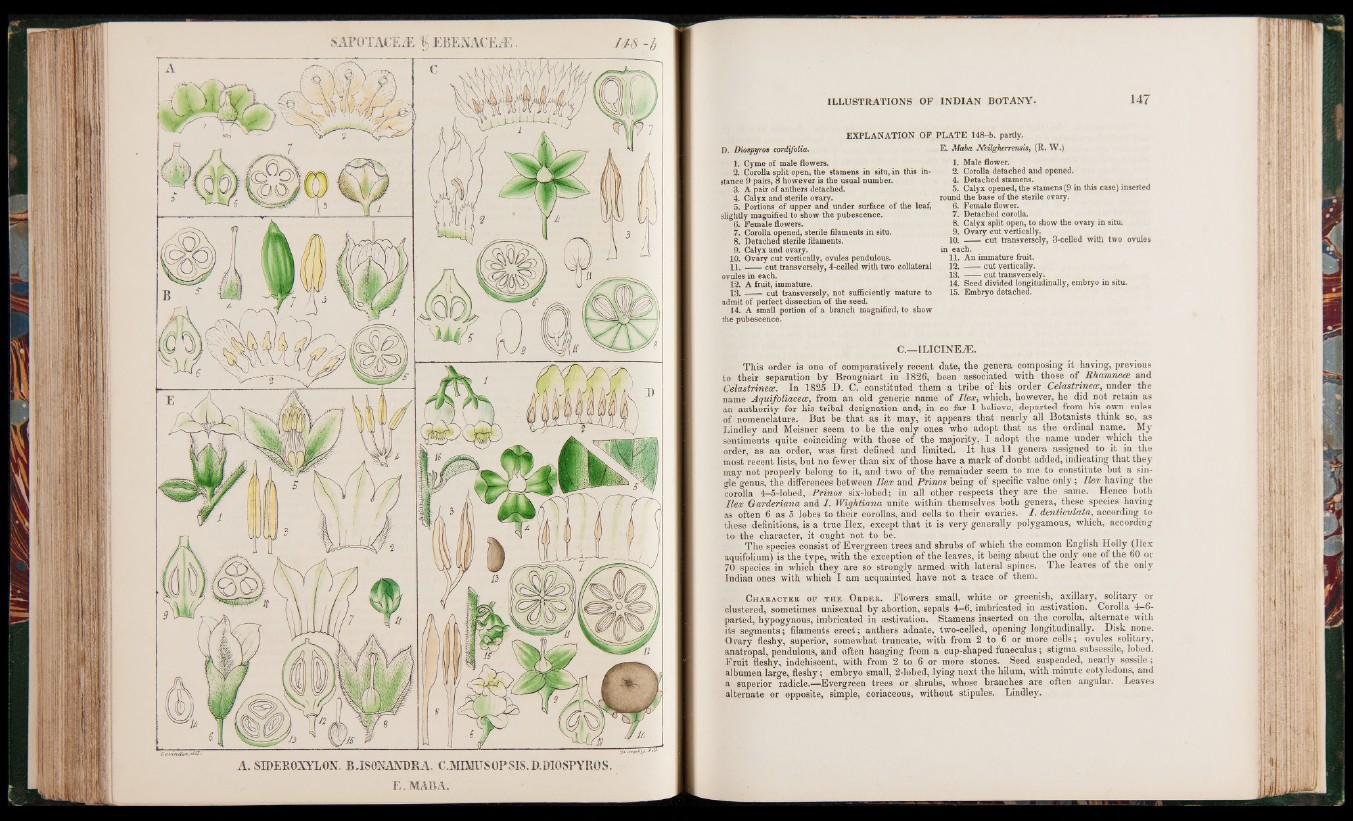
148-1
SAPOTACEÆ EBENACEÆ.
A. SIDEEOXYLON. B JSONANDRA. C.MIMUSOPSIS.D.DIOSPYROS.
E.MABA.
EXPLANATION OF
D. Diospyros cordifolia.
1. Cyme of male flowers.
2. Corolla split open, the stamens in situ, in this instance
9 pairs, 8 however is the usual number.
3. A pair of anthers detached.
4. Calyx and sterile ovary.
5. Portions o f upper and under surface of the leaf,
slightly magnified to show the pubescence.
6. Female flowers.
7. Corolla opened, sterile filaments in situ.
8. Detached sterile filaments.
9. Calyx and ovary.
10. Ovary cut vertically, ovules pendulous.
11. ------ cut transversely, 4-celled with two collateral
ovules in each.
12. A fruit, immature.
1 3 . --- cut transversely, not sufficiently mature to
admit of perfect dissection of the seed.
14. A small portion of a branch magnified, to show
the pubescence.
PLATE 148-b. partly.
E. Maba JVeilgheirensis, (R. W.)
1. Male flower.
2. Corolla detached and opened.
4. Detached stamens.
5. Calyx opened, the stamens (9 in this case) inserted
round the base of the sterile ovary.
6. Female flower.
7. Detached corolla.
8. Calyx split open, to show the ovary in situ.
9. Ovary cut vertically.
1 0 . --------------------- cut transversely, 3-celled with two ovules
in each.
11. An immature fruit.
1 2 . --------------------- cut vertically.
1 3 . --------------------- cut transversely.
14. Seed divided longitudinally, embryo in situ.
15. Embryo detached.
C.—ILICINE^E.
This order is one of comparatively recent date, the genera composing it having, previous
to their separation by Brongniart in 1826, been associated with those of Rhamnece and
Celastrineos. In 1825 D. C. constituted them a tribe of his order Celastrinece, under the
name Aquifoliacece, from an old generic name of Ilex, which, however, he did not retain as
an authority for his tribal designation and, in so far I believe, departed from his own rules
of nomenclature. But be that as it may, it appears that nearly all Botanists think so, as
Lindley and Meisner seem to be the only ones who adopt that as the ordinal name. My
sentiments quite coinciding with those of the majority, I adopt the name under which the
order, as an order, was first defined and limited. I t has 11 genera assigned to it in the
most recent lists, but no fewer than six of those have a mark of doubt added, indicating that they
may not properly belong to it, and two of the remainder seem to me to constitute but a single
genus, the differences between Ilex and Prinos being of specific value only ; Ilex having the
corolla 4-5-lobed, Prinos six-lobed; in all other respects they are the same. Hence both
Ilex Garderiana and I. Wightiana unite within themselves both genera, these species having
as often 6 as 5 lobes to their corollas, and cells to their ovaries. I. denticulata, according to
these definitions, is a true Ilex, except that it is very generally polygamous, which, according
to the character, it ought not to be.
The species consist of Evergreen trees and shrubs of which the common English Holly (Ilex
aquifolium) is the type, with the exception of the leaves, it being about the only one of the 60 or
70 species in which they are so strongly armed with lateral spines. The leaves of the only
Indian ones with which I am acquainted have not a trace of them.
Character of the Order. Flowers small, white or greenish, axillary, solitary or
clustered, sometimes unisexual by abortion, sepals 4-6, imbricated in aestivation. Corolla 4-6-
parted, hypogynous, imbricated in aestivation. Stamens inserted on the corolla, alternate with
its segments; filaments erect; anthers adnate, two-celled, opening longitudinally. Disk none.
Ovary fleshy, superior, somewhat truncate, with from 2 to 6 or more cells; ovules solitary,
anatropal, pendulous, and often hanging from a cup-shaped funeculus; stigma subsessile, lobed.
Fruit fleshy, indehiscent, with from 2 to 6 or more stones. ^ Seed suspended, nearly sessile;
albumen large, fleshy; embryo small, 2-lobed, lying next the hilum, with minute cotyledons, and
a superior radicle.—Evergreen trees or shrubs, whose branches are often angular. Leaves
alternate or opposite, simple, coriaceous, without stipules. Lindley.